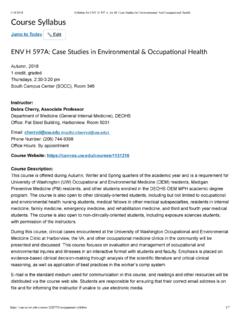Transcription of Case Studies - oregon.gov
1 case Studies Prepared for: oregon Department of Transportation Geo-environmental Section 4040 Fairview Industrial Drive SE MS #6. Salem, OR 97302-1142. Prepared by: Peak Science Communications 8923 W. Ardene Street Suite A. Boise, ID 83709. June 2011. oregon Department of Transportation List of Acronyms List of Acronyms CE Categorical Exclusion CETAS Collaborative Environmental and Transportation Agreement for Streamlining EA Environmental Assessment EIS Environmental Impact Statement EPM Environmental Project Manager FHWA Federal Highway Administration FONSI Finding of No Significant Impact FTA Federal Transit Administration IAMP Interchange Area Management Plan NEPA National Environmental Policy Act ODOT oregon Department of Transportation OTC oregon Transportation Commission OTIA oregon Transportation Investment Act PEL Planning and Environmental Linkages PMT Project Management Team REC Region Environmental Coordinators RTP Regional Transportation Plan STIP State Transportation Improvement Program TAC
2 Technical Advisory Committee TSP Transportation System Plan i oregon Department of Transportation Contents Table of Contents List of Acronyms .. i Introduction .. 1 I-5 to 99W Connector Project .. 3 Springwater Interchange Project .. 5 I-205/Airport Way Project .. 7 Woodburn Interchange Project .. 8 Highway 138E Roseburg .. 13 US 97 Bend North Corridor 15 North Ontario Interchange Area Management Plan .. 17 iii oregon Department of Transportation case Studies Introduction The PEL case Studies have been commissioned to show a variety of ODOT projects that implemented linkage of the planning and environmental processes to varying degrees of success. The intent of conducting these case Studies is to discover linking scenarios that have already occurred and to learn from the challenges and successes of the process as encountered in those projects.
3 These concepts will be carried forward into the development of a comprehensive PEL. guidance document for use throughout ODOT. 1. oregon Department of Transportation case Studies I-5 to 99W Connector Project ODOT Region 1. Planning Document I-5 to 99W Connector Project Alternative Analysis Report Environmental Document Categorical Exclusion ODOT Planning Contact Tim Wilson, Planner ODOT Environmental Contact Scott Richman, Environmental Consultant, David Evans and Associates Project Overview This project was initiated as a joint venture between ODOT, Washington County, and the City of Portland to address increasing congestion of the state highway system between I-5 and Highway 99W in southwest Portland. The I-5 to 99W Connector project was to be conducted in two phases.
4 Phase 1 was a corridor-level planning process for determining the type of project and the location. The I-5 to 99W Connector Project Alternative Analysis Report (Alternatives Analysis) was the product of Phase 1. The planning process resulted in the analysis of seven alternatives, which included high-level environmental considerations that could be advanced to the EIS. Phase 2 of the project was to select and design a project based on the conclusions of Phase 1. However, a partnering agreement between all jurisdictions required unanimous agreement on a Preferred Alternative, which could not be achieved. The project changed direction to focus on local improvements instead. Because the project was no longer a state highway project and would not be using FHWA funds, the project no was longer subject to NEPA and an EIS was not written.
5 Instead, a number of recommendations from the study were included in the Metro Transportation System Plan and funds designated for the project were allocated for local improvements. Planning and Environmental Linkage Implementation The Alternatives Analysis document was developed through the coordination of all State and Federal agencies that would normally be involved in the NEPA process to streamline the EIS. process that would be required in Stage 2. The document was structured and developed with a level of detail similar to a Tier 1 EIS. The study features a chapter devoted to Environmental Effects, with a section describing the comparative evaluation of each alternative's effects for each of the 12 environmental resources as required by NEPA. The environmental information for the Alternatives Analysis came from a combination of Federal, State, and local agency information and data, including Regional Land Information System data provided by Metro.
6 The schedule and budget for the environmental work was incorporated into the Scope of Work for this project. The environmental and land use process took approximately 18 months of the overall project timeline of just over 3 years and cost approximately $420,000 of the $ million expended for the consultant team's work. The PMT. believes the PEL process would definitely have saved time and money during the NEPA phase had the project gone forward with an EIS. Jeff Kaiser, former Major Projects Manager for ODOT and now with David Evans and Associates, outlined the PEL process for this project. His process was favorably received by the managers involved in the project and praised by FHWA officials. The planning process included 3. case Studies oregon Department of Transportation stakeholders from all NEPA-required agency and jurisdictional groups, including CETAS, to develop the project purpose and need, goals, and objectives; evaluation criteria; and range of alternatives.
7 Although this level of involvement does not usually occur until the project-development phase, the stakeholders involved saw the opportunity for early involvement as a way to streamline the environmental process. Although the project took a different direction one that did not require an EIS the environmental framework remains in place and is ready to use should this project be revived in the future. Lessons Learned The PEL implementation model for this project was considered to be very successful by those involved and resulted in a framework that future ODOT projects can use or a model that could be used when developing PEL guidance. In fact, the process is already being used in an informal manner by some ODOT project managers. The planning and environmental staff involved in this project provided the following observations and recommendations: Linking the planning and environmental processes worked well.
8 Working with many jurisdictions complicates the process. Requiring unanimous approval on the Preferred Alternative by all jurisdictions in order to advance the project was a mistake. The real difficulty in linking planning with the environmental process involves public involvement. In the NEPA process, clear boundaries help guide the public involvement process some questions are simply not relevant because NEPA standards preclude them. No such boundaries exist during planning, so public involvement can become extensive and troublesome. The planning analysis is far less detailed than what is required for NEPA, but it serves as a good foundation for further NEPA work. The current Jobs in Transportation funding, which includes projects for which public buy-in has already been established, should serve as a good testing ground for full PEL.
9 Implementation. Two major successes of PEL implementation occurred during this project: The process framework established in this project can serve as a model for other ODOT. projects. The environmental planning approach may have filtered down to local projects. 4. oregon Department of Transportation case Studies Springwater Interchange Project ODOT Region 1. Planning Document US 26: Access to the Springwater Community Interchange Area Management Plan Environmental Document Environmental Assessment (not yet initiated). ODOT Planning Contact Michael Ray, Senior Planner ODOT Environmental Contact Kathy Majidi, City of Gresham Environmental Specialist Project Overview The purpose of this project was to address current and future safety concerns along 26 in the Springwater area.
10 Improved access to the area and planning for future growth were also major concerns. In 2005, the City of Gresham developed their TSP for Springwater, which included a recommendation for a new interchange on 26 and improvements to the existing community street network. The environmental planning process initially began in 2007, but because no funding for construction was available and environmental documents have a limited shelf life, it was decided an EIS would not be warranted at the time. Instead, project leadership chose to develop an IAMP. with the intent to include environmental data in the plan to serve as a foundation for a future EA. The OTC adopted the IAMP and the project is waiting for funding to begin the environmental process. Planning and Environmental Linkage Implementation ODOT and the City of Gresham worked with Parametrix to assemble interested environmental specialists and stakeholders, specifically from the Johnson Creek Watershed Council and Metro.



















